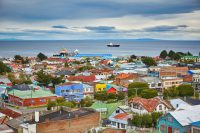Some of the most stunning design in contemporary interiors features Patagonia granite. Subtle speckles of deep black, pale gold, espresso brown, and shimmering, translucent planes, make this stone one of the most prized types of granite. Quarried in Brazil – not Patagonia, surprisingly – this remarkable stone is also known as Patagonia quartzite. This is due to the rock’s high concentration of quartz.
The incredible luster and natural shimmer of Patagonia granite make it difficult to believe that this material occurs naturally. Here, we’ll give you a basic insight into how this precious material forms in the volcanic regions of South America.
How does Patagonia granite form?
South America is full of amazing geological features. From the towering Andes to the breathtaking Torres del Paine, the landscape of Chile, Argentina, and southern Brazil is certain to impress even the most seasoned explorer. It is millions of years of volcanic eruptions, tectonic activity, and glacial movement that forms these incredible geological features – including Patagonia granite.
Broadly speaking, there are three different types of rock. These are sedimentary, metamorphic and igneous rock. Geologists classify each rock type depending on its formation. For example, sedimentary rocks are formed by the accumulation of shells, pebbles, sands and other particles. On the other hand, metamorphic rocks are formed under the Earth’s crust by the intense pressure and heat that emanates from the center of the planet.
Patagonia granite is an igneous rock, which forms as a result of volcanic activity. In volcanic regions, the magma, or molten rock, that makes up the Earth’s core is closer to the surface. As the magma rises slowly toward the upper levels of the Earth’s crust, it begins to cool and crystalize. It is this very gradual process that allows the granite to draw in the various different materials that create its colorful, complex surface.
What creates the stone’s beautiful colors?
The different grains seen in a block of Patagonia granite include quartz, feldspar, amphiboles, mica, iron oxide and numerous other minerals. It’s the unique mineral composition of each type of granite that create its distinctive appearance. For instance, it is the large concentration of quartz that gives Patagonia granite it’s milky, translucent sections.
Some slabs of Patagonia granite have hints of gold. Over millions of years, water will penetrate the stone through small cracks and fissures. Subsequently, this causes the iron particles to oxidize, producing the luscious gold tones present in the surface.
What are the uses of Patagonia granite?
The complex composition of Patagonia granite means that it shimmers and sparkles. This makes the stone an extremely attractive material for decorating both homes and public spaces. Furthermore, granite is an extremely durable, resilient material that makes it practical as well as beautiful.
You can make kitchen countertops, sinks, bathtubs, floors, walls, or columns from Patagonia granite. Some creative interior designers will even light this gorgeous granite from within, creating a glow that emanates through the pale white quartz. However, these elegant designs come at a price – one square meter of Patagonia granite costs between $200-$400, or up to $600 per square meter for the most pristine slabs.
No comments yet
There are no comments on this post yet.




Leave a comment